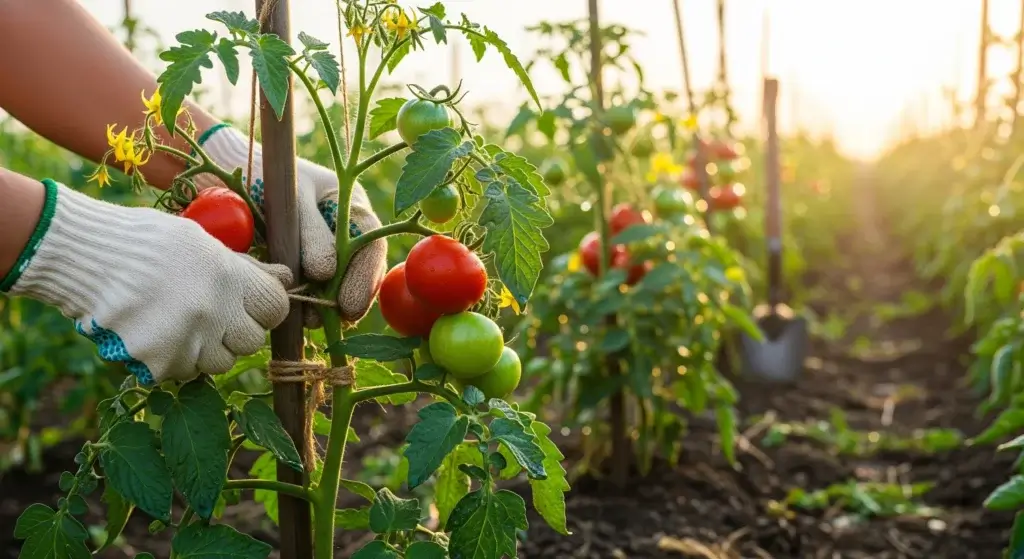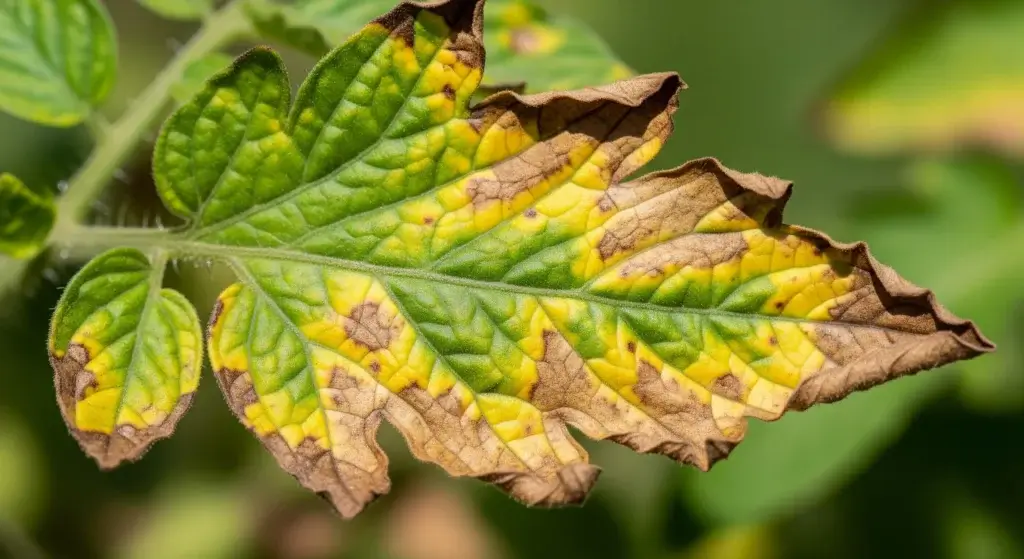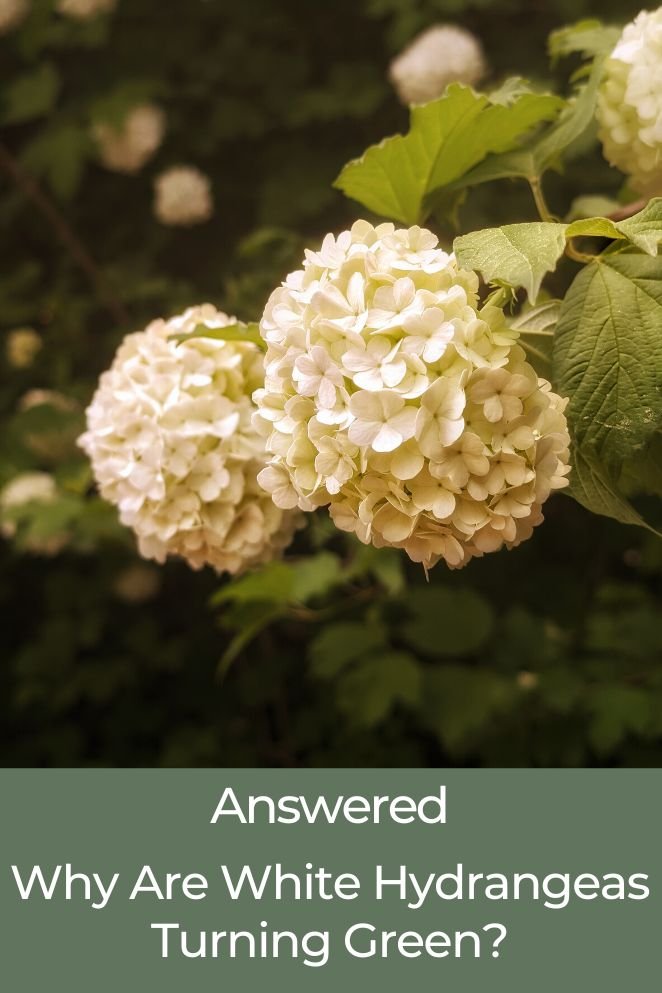
Have you ever noticed your pristine white hydrangeas mysteriously turning green?
It’s a common frustration among gardeners, but fear not! In this comprehensive guide, we’ll delve into the reasons behind this color transformation and provide practical solutions to maintain the purity of your white blooms.
About Hydrangeas
Flower
Large and showy
The most striking feature of hydrangeas is their large, densely packed clusters of blooms.
These clusters, called inflorescences, can reach several inches in diameter and contain dozens of individual flowers.
Shape
Flowerheads come in three main shapes:
- Mophead: Round and resemble pom-poms, with mostly sterile, showy flowers.
- Lacecap: Flattened with both fertile and sterile flowers, the fertile ones being smaller and centrally located.
- Panicle: Elongated and cone-shaped, with mostly fertile flowers.
Color
While traditionally associated with blue and pink, hydrangeas boast a wider spectrum of natural hues, including green, white, purple, and even red.
The color can be influenced by soil pH, with acidic soil favoring blues and alkaline soil promoting pinks.
- Read also: Purple Prickly Pear Cactus Care
- Read also: Unveiling the Beauty of Peperomia Flower Spikes
Leaves
Hydrangea leaves are large, broad, and oval-shaped. They have a serrated edge, glossy and a dark green color.
The leaves are arranged oppositely on the stems.
Stems and branches
White hydrangeas typically have sturdy stems and branches that support the weight of the flower clusters.
Depending on the variety, the stems may be woody or herbaceous.
Its color is usually green, but can also be brown or red.
Size
Hydrangeas come in a variety of sizes, from dwarf varieties that only grow a few feet tall to large shrubs that can reach up to 10 feet tall.
Growth Habit
Hydrangeas are typically bushy shrubs, but they can also be trained to grow as vines or tree-like forms.
Fragrance
While not all white hydrangea varieties are known for their fragrance, some may emit a subtle, sweet scent that adds to the sensory experience of being in the garden.
However, the primary appeal of white hydrangeas lies in their visual beauty rather than their fragrance.
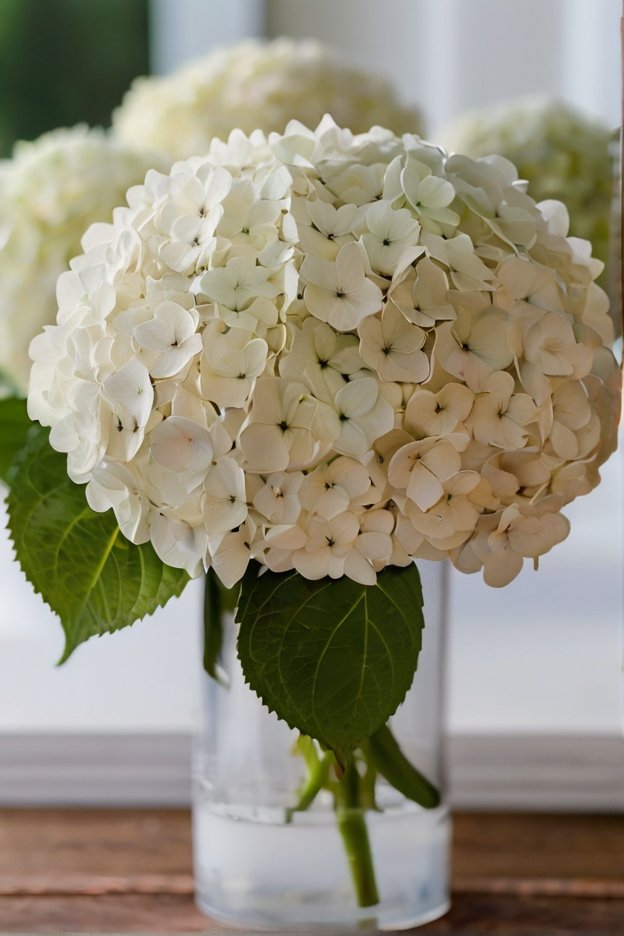
Range of Natural Color Variations of Hydrangea Flower
Hydrangeas are nature’s paintbrushes, boasting a breathtaking range of natural color variations that go beyond the classic blue and pink.
From vibrant blues and purples to soft greens and creamy whites.
Here’s a glimpse into their diverse color palette:
White
There are several varieties of white hydrangeas, including the popular ‘Annabelle’, ‘Incrediball’, and ‘Limelight’.
Each variety may differ slightly in terms of flower size, shape, and growth habit.
Pure white hydrangeas, like ‘Annabelle’ and ‘White Wedding,’ remain white in all soil conditions, offering timeless elegance and versatility.
Green
This unique color arises in varieties like ‘Limelight’ and ‘Pistachio,’ regardless of soil pH.
Their blooms start white and transition to green as they mature, adding a fresh, unexpected element to the garden.
Red
True red is rare in hydrangeas, but some varieties like ‘Red Sensation’ exhibit deep pink blooms that appear reddish under certain lighting conditions.
Hot pink
For a bolder statement, varieties like ‘Forever Pink’ and ‘Blushing Bride’ produce vibrant hot pink blooms in slightly alkaline soil.
Soft pink
Neutral to slightly alkaline soil (pH 6.0-7.0) encourages hydrangeas to produce charming shades of soft pink, perfect for a whimsical garden.
Purple
In certain varieties and slightly acidic soil, hydrangeas can boast rich purple blooms, adding a regal touch to the landscape.
Mauve and lavender
As soil pH becomes slightly less acidic, the blue tones soften into delicate mauves and lavenders, adding a touch of romance to the garden.
Sky blue
A lighter, airier take on blue, often seen in varieties like ‘Endless Summer’ and ‘Blueberry Cheesecake.’
They still require acidic soil for their vibrant hue.
Deep, inky blue
This mesmerizing shade epitomizes hydrangea elegance. It’s achieved in acidic soils (pH below 6.0) where readily available aluminum interacts with flower pigments, creating the iconic blue.

Factors that Influence Natural Color Variations in Hydrangeas
Hydrangeas are renowned for their captivating ability to display a wide range of colors, and this natural phenomenon stems from their unique sensitivity to soil pH and aluminum levels.
Here’s a closer look at the natural color variations in hydrangeas and the factors that influence them:
The Magic of Soil pH
The primary driver of color variation in hydrangeas is soil pH.
These remarkable plants act as natural pH indicators, utilizing the availability of aluminum in the soil to produce different blooms.
Acidic soil (pH below 6.0)
In acidic environments, aluminum readily dissolves, allowing hydrangeas to absorb it.
This aluminum complexes with flower pigments called anthocyanins, resulting in vibrant blue blooms.
Neutral to alkaline soil (pH above 6.0)
As the soil pH increases, aluminum becomes less available.
This leads to the production of different anthocyanins, resulting in pink or lavender blooms.
Very alkaline soil (pH above 7.0)
In highly alkaline conditions, aluminum uptake is minimal, and hydrangeas primarily produce pigments other than anthocyanins. This often results in green or white blooms.
Aluminum availability
Aluminum can affect pigment production of hydrangea flowers. In acidic soil, aluminum is soluble and readily taken up by the plant’s roots.
This aluminum presence in the plant leads to the formation of blue pigments in the flowers.
In contrast, in alkaline soil, aluminum becomes less available to the plant, resulting in pink or red blooms.
Nutrient availability
Deficiencies in certain nutrients, like nitrogen, can affect pigment production and lead to paler blooms.
Genetics
Different hydrangea varieties have inherent color tendencies, regardless of soil pH.
For instance, some varieties boast white or green blooms even in acidic conditions.
Others may start off with white flowers that gradually transition to shades of pink, blue, or purple as they age.
Environmental conditions
In addition to soil pH and aluminum levels, environmental factors such as sunlight exposure, temperature, and moisture levels can also influence hydrangea bloom color.
For example, hydrangeas grown in full sun may develop deeper or more intense colors compared to those grown in partial shade.
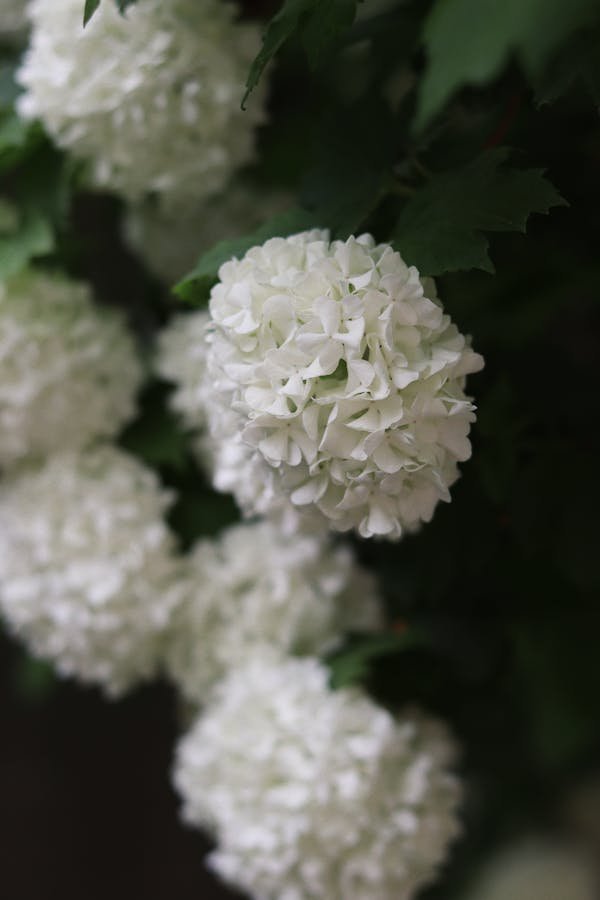
Why White Hydrangeas Turn Green
There are two main reasons why your white hydrangea might be turning green:
Natural color change
This is the most likely reason, especially if your hydrangea is nearing the end of its blooming season.
As hydrangea blooms age, the pigment responsible for their bright colors (pink, blue, or white) fades, revealing the green chlorophyll pigments underneath.
This is a natural process and nothing to worry about. In fact, many gardeners appreciate the additional visual interest that these green-tinged hydrangeas bring to their gardens.
Indication
If your hydrangea has been blooming for a while (typically more than 2 weeks), the greening is likely due to natural fading. Newer blooms are less likely to be showing green already.
Variety specific
Some hydrangea varieties, like the Limelight hydrangea, naturally have blooms that start white and transition to green over time. These varieties are bred specifically for this color transformation and it’s perfectly normal for them to show green hues.
Indication
Check the type of hydrangea you have and research its specific blooming characteristics.
If it’s known for color-changing blooms, then the greening is normal.
Other reason that maybe impact the changing color of hydrangea flower:
Sun exposure
Excessive sunlight can prompt the chlorophyll levels in the leaves to rise, resulting in a greener appearance. Providing partial shade can help mitigate this effect.
Nutrient levels
Imbalances in soil nutrients, particularly nitrogen, can lead to lush green growth at the expense of flower color.
Ensuring appropriate fertilization based on soil test results can help maintain the desired white hue.
Environmental stress
Drought, heat, or inadequate watering can induce stress in hydrangeas, prompting a shift in foliage color as a response.
Consistent watering practices and providing adequate moisture during hot weather can help alleviate stress.
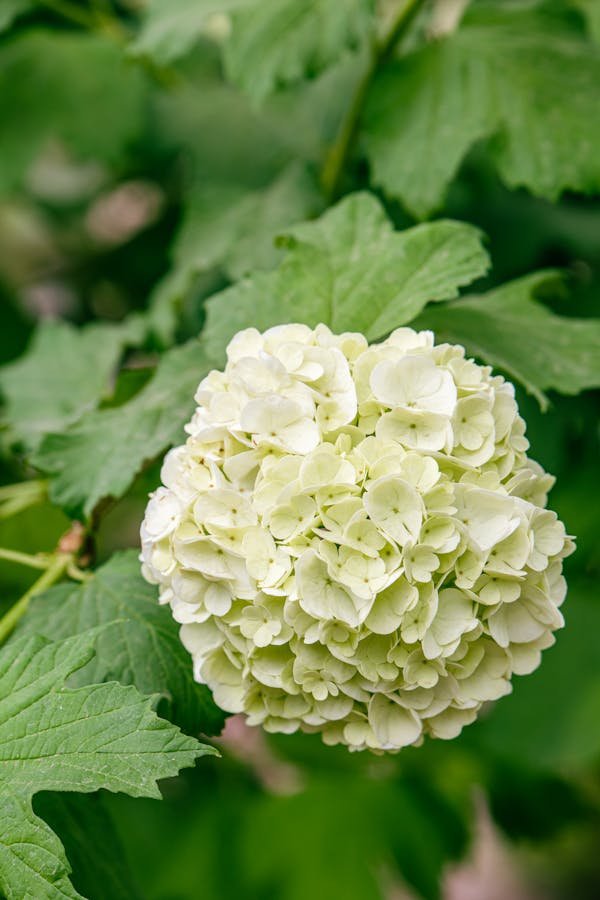
How to Control Hydrangeas from Turning Green
Consider the following strategies to control hydrangeas from turning green:
Provide consistent moisture
Ensure the soil remains moist without becoming soggy, particularly in warmer climates where hydrangeas are prone to turning green.
Use a balanced fertilizer
Feed hydrangeas with a well-balanced fertilizer containing adequate amounts of nitrogen, phosphorus, and potassium in springtime
Maintain optimal soil pH
Hydrangeas prefer acidic soil; maintain a soil pH between 5.5–6.5 for blue and pink flowers, and avoid adding excessive amounts of limestone or calcium-rich products
Choose suitable locations
Plant hydrangeas in areas with partial shade, avoiding direct exposure to midday sun, especially in hot climates.
Adjust environmental conditions
Monitor temperature and humidity levels, ensuring they remain within the range preferred by hydrangeas—generally, they do better in cooler environments.
Pruning flower
If you don’t like the green color, you can deadhead the spent blooms to encourage new, vibrant blooms. However, keep in mind that some varieties (like Limelight) will always develop green tones as they mature.
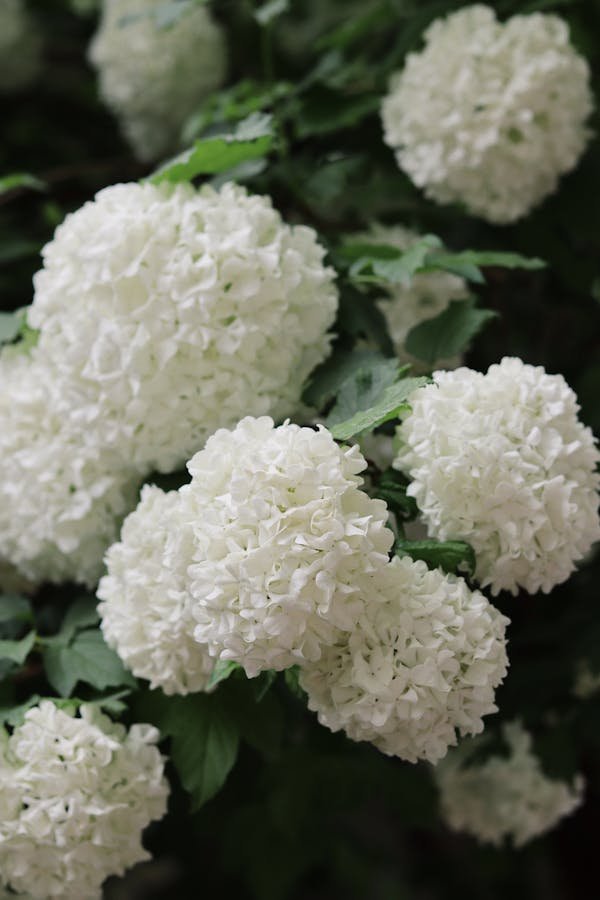
- Read also: Mastering Dragon Wing Begonia Care
- Read also: A Guide to Dracaena Colorama Care
Conclusion
Renowned for their captivating range of hues, hydrangeas possess a remarkable ability to display a diverse spectrum of colors.
Pure white hydrangeas offer timeless elegance and versatility.
Controlling white hydrangeas from turning green requires understanding the reasons behind the color change and addressing them.
By grasping the factors influencing their color transformation, you can relish the beauty of colorful blooms in your garden throughout the year.
FAQs
While coffee grounds can contribute to soil acidity over time, it’s best to use specialized pH-adjusting products for more precise control.
Pruning hydrangeas at the wrong time can remove potential blooms, but it won’t directly impact their coloration.
Some cultivars, like ‘Annabelle’ and ‘Incrediball,’ are known for their color stability, but proper care is still crucial for maintaining white blooms.

